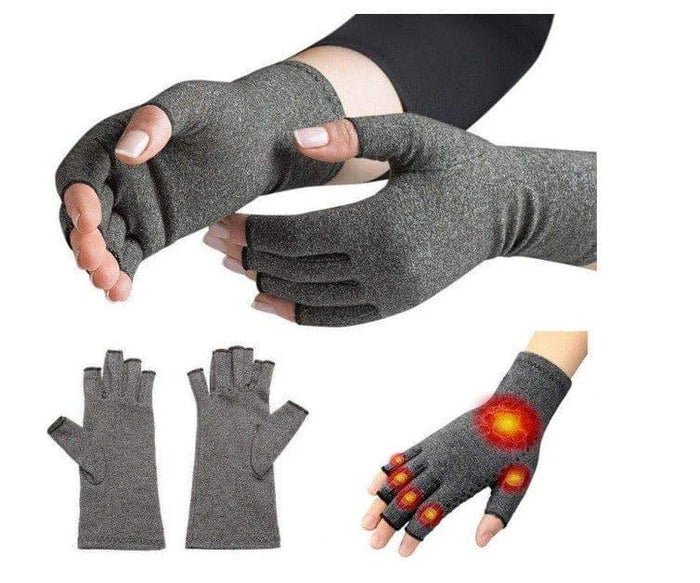Living with arthritis in your hands can be tough. From opening jars to typing on a keyboard, pain and stiffness can make daily tasks a struggle. Compression gloves have become a popular solution, but with so many options and questions, it’s hard to know what really works. In this blog, we’ll answer the most frequently asked questions about compression arthritis gloves, so you can make an informed choice for your hand health.
Are Compression Gloves Any Good for Arthritis?
Yes, compression gloves can help manage arthritis symptoms by providing gentle pressure, warmth, and support to your hands. They’re not a cure, but many users find them helpful for reducing pain, swelling, and stiffness—especially during flare-ups or cold weather.
What Compress is Best for Arthritis?
Both cold and warm compresses can help arthritis, but compression gloves primarily provide warmth and gentle pressure, which many people find soothing for stiff, painful joints. For acute swelling, a cold pack may be more effective; for chronic pain and stiffness, warmth is usually preferred.
Should You Sleep with Compression Gloves On?
Sleeping in compression gloves can help reduce morning stiffness and pain, especially for those with rheumatoid arthritis. Start by wearing them during the day to get used to the feeling, and only wear them overnight if they remain comfortable and do not cause numbness or tingling.
What Size Compression Gloves Do I Need?
To find the right size, measure your hand around the knuckles (excluding the thumb) and consult the sizing chart provided by the manufacturer. Gloves should fit snugly but not tightly—too-tight gloves can cause discomfort or restrict circulation.
Do Arthritis Bracelets Work?
Arthritis bracelets, like copper or magnetic bands, are marketed for pain relief, but scientific evidence supporting their effectiveness is limited. Compression gloves, on the other hand, have more research backing their use for symptom management.
How to Treat Painful Arthritic Hands?
-
Use compression gloves for warmth and support.
-
Apply heat or cold as needed.
-
Perform gentle hand exercises to maintain flexibility.
-
Take prescribed medications.
-
Consult with a healthcare professional for tailored treatment.
What Are the Signs of Arthritis in Your Fingers?
Common signs include:
-
Pain and tenderness
-
Swelling
-
Stiffness, especially in the morning
-
Reduced range of motion
-
Visible changes in joint shape
How Can I Stop Arthritis from Getting Worse in My Hands?
-
Stay active with gentle hand exercises.
-
Use compression gloves for support.
-
Protect your joints by avoiding repetitive, high-strain activities.
-
Manage inflammation with medication as prescribed.
-
Maintain a healthy weight and diet.
Do Hand Warmers Help Arthritis?
Hand warmers can provide temporary relief by increasing blood flow and reducing stiffness. Compression gloves offer similar benefits by trapping warmth and applying gentle pressure.
How Long Can You Safely Wear Compression Gloves?
You can wear compression gloves for several hours at a time, including overnight. Avoid wearing them 24/7 to maintain skin health. Take breaks and ensure your hands are dry before putting them on again.
Is Heat Good for Arthritis?
Yes, heat can help relax muscles, reduce stiffness, and relieve pain in arthritic hands. Compression gloves provide mild heat retention, which many users find beneficial.
Do Heated Gloves Work for Arthritis?
Heated gloves can offer additional warmth, which may further reduce stiffness and pain. However, ensure they fit well and are not too hot to avoid burns or discomfort.
Real User Experiences
Many people report that compression gloves help them manage daily activities with less pain and swelling. Some note improved grip and dexterity, while others simply appreciate the warmth and comfort. However, not everyone experiences dramatic results—benefits can vary from person to person.
Tips for Getting the Most from Your Compression Gloves
-
Choose gloves made from comfortable, breathable materials.
-
Make sure they fit properly—snug, not tight.
-
Wash regularly to keep them clean and maintain elasticity.
-
Replace gloves every 4–6 months or when they lose their stretch.
-
Combine glove use with other treatments for best results.
Conclusion
Compression gloves are a simple, non-invasive tool that can help many people with arthritis manage hand pain, swelling, and stiffness. While they’re not a cure and results vary, their warmth, support, and gentle pressure make daily life a little easier for thousands of users. If you’re considering compression gloves, consult your healthcare provider to find the best fit for your needs—and enjoy more comfortable, functional hands.

